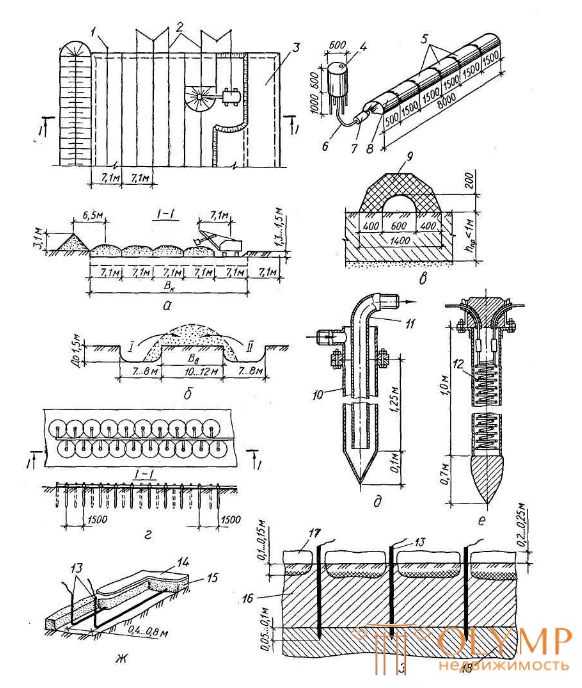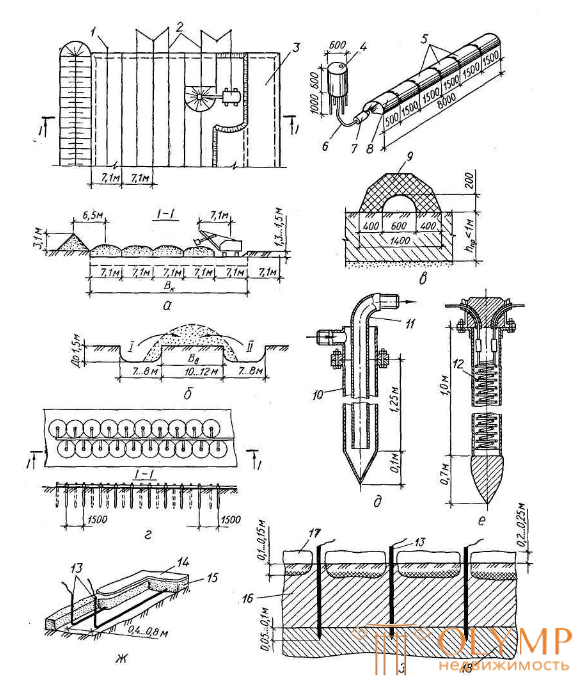
This method is based on the artificial creation on the surface of the site, scheduled for development in the winter, of a thermal insulation cover with the development of soil in the thawed state. The protection is carried out before the onset of stable negative temperatures, with an advance diversion from the insulated area of surface water. The following methods of thermal insulation coatings are used: preliminary loosening of the soil, plowing and harrowing of the soil, cross-loosening, covering the surface of the soil with insulators, etc.
Preliminary loosening of the soil , as well as plowing and harrowing is carried out on the eve of the onset of the winter period in the area intended for development in winter conditions. When loosening the surface of the soil, the top layer acquires a loose structure. tour with air-filled closed voids with sufficient thermal insulation properties. Plowing is done by tractor plows or rippers to a depth of 30 ... 35 cm, followed by harrowing to a depth of 15 ... 20 cm. Such treatment, combined with naturally formed snow cover, postpones the onset of soil freezing for 1.5 months, and for the subsequent period reduces a total depth of approximately 1 freezing 13. snow cover can be enlarged by moving snow on motor graders or bulldozers portion or installing perpendicular direction of the prevailing winds several rows of snow protection fence lattice panels Dimensions 2x2 m at a distance of 20 ... 30 m range from the series.

Deep loosening is done by excavators to a depth of 1.3 ... 1.5 m by transferring the soil to be developed at the site where the earthen structure will be located later.
Cross loosening of the surface to a depth of 30 ... 40 cm, the second layer of which lies at an angle of 60 ... 90 °, and each subsequent penetration is performed with an overlap of 20 cm. Such processing, including snow cover, postpones the beginning of freezing of the soil by 2, 5 ... 3.5 months, the total depth of freezing is sharply reduced.
Preliminary treatment of the soil surface by mechanical loosening is especially effective at warming these areas of land.
Shelter ground surface insulation . To do this, use cheap local materials - woody leaves, dry moss, peat breeze, straw mats, shavings, sawdust, snow. The easiest way is to lay these heaters with a layer thickness of 20 ... 40 cm directly along the ground. Such surface insulation is used mainly for small areas of grooves.
Shelter with an air gap . More effective is the use of local materials in combination with the air gap. To do this, lay on the surface of the ground lying 8 .- .. 10 cm thick, on them slabs or other improvised material - branches, twigs, reeds; a layer of sawdust or wood shavings 15 ... 20 cm thick is poured over them from the top to protect them from being blown away by the wind. Such a shelter is extremely effective in conditions of middle Russia, it actually protects the soil from freezing throughout the winter. It is advisable to increase the area of shelter (insulation) on each side by 2 ... 3 m, which will prevent the soil from freezing not only from above, but also from the side.
With the beginning of the development of the soil, it should be carried out at a fast pace, right away to the entire required depth and in small sections. In this case, the heat-insulating layer should be removed only on the developed area, otherwise, in case of severe frosts, a frozen crust of the soil will quickly form, making it difficult to carry out the work.
Что бы оставить комментарий войдите
Комментарии (0)